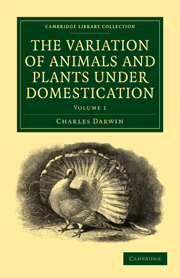Book contents
- Frontmatter
- Contents
- LIST OF ILLUSTRATIONS
- INTRODUCTION
- CHAPTER I DOMESTIC DOGS AND CATS
- CHAPTER II HORSES AND ASSES
- CHAPTER III PIGS — CATTLE — SHEEP — GOATS
- CHAPTER IV DOMESTIC RABBITS
- CHAPTER V DOMESTIC PIGEONS
- CHAPTER VI PIGEONS—continued
- CHAPTER VII FOWLS
- CHAPTER VIII DUCKS — GOOSE — PEACOCK — TURKEY — GUINEA-FOWL — CANARY-BIRD — GOLD-FISH — HIVE-BEES—SILK-MOTHS
- CHAPTER IX CULTIVATED PLANTS: CEREAL AND CULINARY PLANTS
- CHAPTER X PLANTS continued — FRUITS — ORNAMENTAL TREES — FLOWERS
- CHAPTER XI ON BUD-VARIATION, AND ON CERTAIN ANOMALOUS MODES OF REPRODUCTION AND VARIATION
CHAPTER VI - PIGEONS—continued
Published online by Cambridge University Press: 05 October 2010
- Frontmatter
- Contents
- LIST OF ILLUSTRATIONS
- INTRODUCTION
- CHAPTER I DOMESTIC DOGS AND CATS
- CHAPTER II HORSES AND ASSES
- CHAPTER III PIGS — CATTLE — SHEEP — GOATS
- CHAPTER IV DOMESTIC RABBITS
- CHAPTER V DOMESTIC PIGEONS
- CHAPTER VI PIGEONS—continued
- CHAPTER VII FOWLS
- CHAPTER VIII DUCKS — GOOSE — PEACOCK — TURKEY — GUINEA-FOWL — CANARY-BIRD — GOLD-FISH — HIVE-BEES—SILK-MOTHS
- CHAPTER IX CULTIVATED PLANTS: CEREAL AND CULINARY PLANTS
- CHAPTER X PLANTS continued — FRUITS — ORNAMENTAL TREES — FLOWERS
- CHAPTER XI ON BUD-VARIATION, AND ON CERTAIN ANOMALOUS MODES OF REPRODUCTION AND VARIATION
Summary
The differences described in the last chapter between the eleven chief domestic races and between individual birds of the same race, would be of little significance, if they had not all descended from a single wild stock. The question of their origin is therefore of fundamental importance, and must be discussed at considerable length. No one will think this superfluous who considers the great amount of difference between the races, who knows how ancient many of them are, and how truly they breed at the present day. Fanciers almost unanimously believe that the different races are descended from several wild stocks, whereas most naturalists believe that all are descended from the Columba livia or rock-pigeon.
Temminck has well observed, and Mr. Gould has made the same remark to me, that the aboriginal parent must have been a species which roosted and built its nest on rocks; and I may add that it must have been a social bird. For all the domestic races are highly social, and none are known to build or habitually to roost on trees. The awkward manner in which some pigeons, kept by me in a summer-house near an old walnut-tree, occasionally alighted on the barer branches, was evident. Nevertheless, Mr. R. Scot Skirving informs me that he often saw crowds of pigeons in Upper Egypt settling on the low trees, but not on the palms, in preference to the mud hovels of the natives.
- Type
- Chapter
- Information
- The Variation of Animals and Plants under Domestication , pp. 180 - 224Publisher: Cambridge University PressPrint publication year: 2010First published in: 1868



